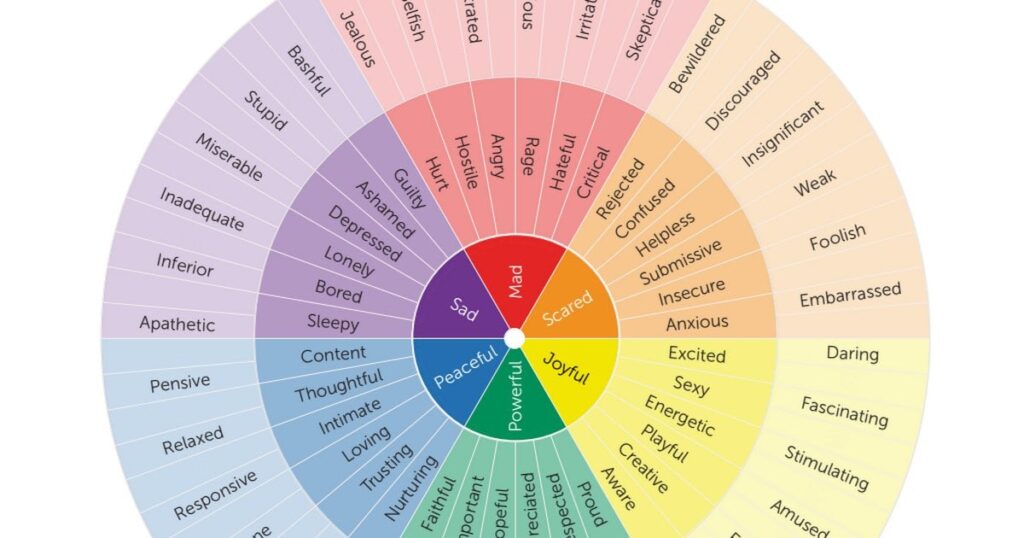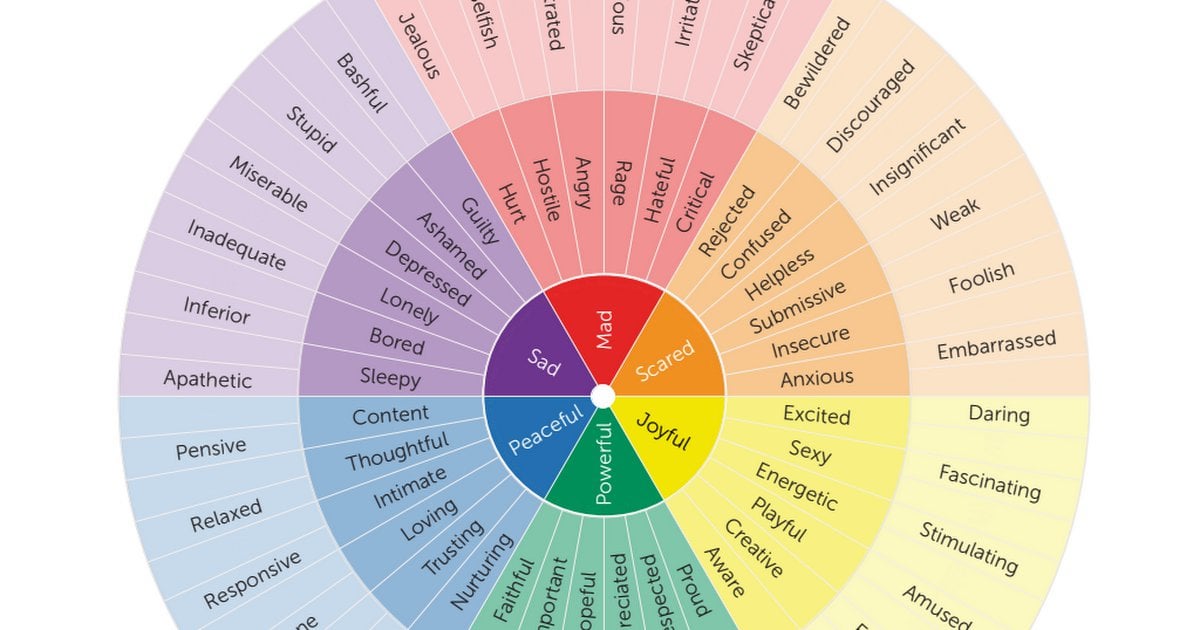
Unlocking Emotional Intelligence: A Comprehensive Guide to the Feelings Wheel
In the realm of emotional intelligence, understanding and articulating our emotions is paramount. The feelings wheel emerges as a powerful tool for navigating the complex landscape of human emotions. This visual aid, often structured as a color-coded diagram, allows individuals to identify and label their feelings with greater precision. In this comprehensive guide, we will delve into the intricacies of the feelings wheel, exploring its origins, applications, and benefits for personal and professional development. Whether you’re a seasoned therapist, a curious student, or simply someone seeking to enhance your emotional literacy, the feelings wheel offers a valuable framework for self-discovery and improved communication.
The Origins and Evolution of the Feelings Wheel
The concept of the feelings wheel can be traced back to various sources, but one of the most influential is Dr. Gloria Willcox’s “The Feeling Wheel,” developed in the 1980s. Willcox’s wheel aimed to provide a more nuanced vocabulary for emotions than the simplistic “happy,” “sad,” and “angry.” This initial design has since been adapted and refined by numerous psychologists, therapists, and educators, leading to a variety of feelings wheel designs available today.
Different versions of the feelings wheel may vary in their structure and the specific emotions they include, but they all share a common goal: to help individuals expand their emotional vocabulary and connect with their inner experiences. Some wheels organize emotions hierarchically, with core emotions at the center and more nuanced feelings radiating outward. Others categorize emotions based on their valence (positive or negative) or intensity.
How the Feelings Wheel Works: A Practical Guide
Using the feelings wheel is a straightforward process, but its impact can be profound. Here’s a step-by-step guide to effectively utilizing this tool:
- Identify the Initial Feeling: Start by acknowledging the primary emotion you’re experiencing. This might be a general feeling of happiness, sadness, anger, or fear.
- Locate the Core Emotion: Find the core emotion on the innermost circle of the feelings wheel. These are typically the basic emotions that serve as the foundation for more complex feelings.
- Explore the Outer Layers: Move outward from the core emotion to explore more nuanced and specific feelings. For example, if your core emotion is “sad,” you might find feelings like “disappointed,” “lonely,” or “grief-stricken” in the outer layers.
- Choose the Most Accurate Label: Select the word that best describes your feeling. Don’t be afraid to consider multiple options and choose the one that resonates most strongly with your experience.
- Reflect on the Feeling: Once you’ve identified and labeled your feeling, take some time to reflect on it. Ask yourself: What triggered this feeling? What thoughts and behaviors are associated with it? How can I manage this feeling in a healthy way?
The feelings wheel is not just about labeling emotions; it’s about understanding them. By connecting with your feelings and exploring their nuances, you can gain valuable insights into your thoughts, behaviors, and relationships. [See also: Understanding Emotional Regulation]
Benefits of Using the Feelings Wheel
The benefits of using a feelings wheel extend far beyond simply expanding your emotional vocabulary. Here are some key advantages:
- Enhanced Emotional Awareness: The feelings wheel encourages you to pay attention to your emotions and become more aware of your inner experience.
- Improved Communication: By providing a more precise language for emotions, the feelings wheel can help you communicate your feelings more effectively to others. This can lead to stronger and more fulfilling relationships.
- Increased Self-Regulation: Understanding your emotions is the first step towards regulating them. The feelings wheel can help you identify triggers, manage intense emotions, and develop healthier coping mechanisms.
- Reduced Stress and Anxiety: By acknowledging and processing your emotions, you can reduce stress and anxiety levels. Suppressing emotions can lead to increased tension and emotional distress.
- Improved Decision-Making: Emotions play a significant role in decision-making. By understanding your emotions, you can make more informed and rational decisions.
- Greater Empathy: Recognizing and understanding your own emotions can enhance your ability to empathize with others. The feelings wheel can help you understand the emotional experiences of those around you.
Applications of the Feelings Wheel in Various Settings
The feelings wheel is a versatile tool that can be applied in a variety of settings, including:
Therapy and Counseling
Therapists and counselors often use the feelings wheel to help clients explore their emotions and identify underlying issues. It can be particularly helpful for individuals who struggle to articulate their feelings or who have difficulty identifying the root causes of their emotional distress. [See also: Cognitive Behavioral Therapy Techniques]
Education
The feelings wheel can be a valuable tool for teaching emotional literacy to children and adolescents. It can help them develop a vocabulary for emotions and learn how to express their feelings in a healthy way. Many schools incorporate the feelings wheel into their social-emotional learning curriculum.
Coaching and Leadership Development
Coaches and leadership development professionals use the feelings wheel to help individuals enhance their emotional intelligence and improve their leadership skills. Understanding and managing emotions is crucial for effective leadership and teamwork. The feelings wheel can also aid in conflict resolution by helping individuals understand the emotions driving their behavior and the behavior of others.
Personal Development
The feelings wheel is a valuable tool for anyone seeking to improve their self-awareness and emotional well-being. It can be used as a daily practice to check in with your emotions and gain a deeper understanding of yourself. Using a feelings wheel can be a daily habit, helping you to understand yourself at a deeper level.
Criticisms and Limitations of the Feelings Wheel
While the feelings wheel is a valuable tool, it’s important to acknowledge its limitations. Some critics argue that the feelings wheel can be overly simplistic and may not capture the full complexity of human emotions. Others point out that the feelings wheel may be culturally biased, as different cultures may have different ways of expressing and understanding emotions.
It’s also important to remember that the feelings wheel is just a tool, and it’s not a substitute for professional help. If you’re struggling with significant emotional distress, it’s essential to seek support from a qualified therapist or counselor.
Choosing the Right Feelings Wheel
With so many different versions of the feelings wheel available, it’s important to choose one that resonates with you and meets your specific needs. Consider the following factors when selecting a feelings wheel:
- Structure: Do you prefer a hierarchical structure with core emotions at the center, or a more categorical approach?
- Vocabulary: Does the feelings wheel include the emotions that are most relevant to your experience?
- Design: Is the feelings wheel visually appealing and easy to use?
- Accessibility: Is the feelings wheel available in a format that works for you (e.g., print, digital, mobile app)?
Experiment with different feelings wheel designs until you find one that feels comfortable and effective for you. It is important to find a feelings wheel that is helpful to you.
Tips for Maximizing the Effectiveness of the Feelings Wheel
To get the most out of your feelings wheel, consider these tips:
- Use it regularly: Make it a habit to check in with your emotions using the feelings wheel on a daily or weekly basis.
- Be honest with yourself: Don’t be afraid to acknowledge difficult or uncomfortable emotions.
- Explore the nuances: Take the time to explore the different layers of the feelings wheel and identify the most accurate label for your feeling.
- Reflect on your feelings: Ask yourself what triggered the feeling and how you can manage it in a healthy way.
- Share your feelings with others: Use the feelings wheel to communicate your feelings to friends, family, or a therapist.
The Future of Emotional Intelligence and the Feelings Wheel
As emotional intelligence becomes increasingly recognized as a critical skill for success in all areas of life, the feelings wheel is likely to play an even more prominent role in personal and professional development. With ongoing research and development, we can expect to see even more sophisticated and user-friendly feelings wheel designs emerge in the future. These advancements will further empower individuals to understand, manage, and express their emotions effectively, leading to greater well-being and more fulfilling lives. The feelings wheel helps to foster a more emotionally aware and intelligent society.
In conclusion, the feelings wheel is a powerful tool for unlocking emotional intelligence and enhancing self-awareness. By providing a structured framework for identifying and labeling emotions, it can help individuals improve communication, regulate their feelings, reduce stress, and make more informed decisions. Whether you’re a seasoned therapist or someone just beginning to explore your emotional landscape, the feelings wheel offers a valuable resource for personal growth and well-being. Embrace the feelings wheel as a guide on your journey to emotional mastery, and unlock the potential for a more fulfilling and meaningful life. Consider integrating the feelings wheel into your daily routine and observe the positive impact it can have on your emotional health and relationships.

